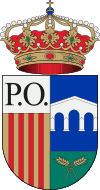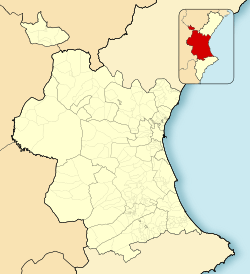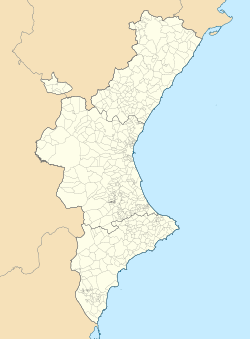Quart de Poblet facts for kids
Quick facts for kids
Quart de Poblet
|
||
|---|---|---|
 |
||
|
||
| Country | ||
| Autonomous community | ||
| Province | ||
| Comarca | Horta Oest | |
| Judicial district | Quart de Poblet | |
| Area | ||
| • Total | 19.6 km2 (7.6 sq mi) | |
| Elevation | 40 m (130 ft) | |
| Population
(2018)
|
||
| • Total | 24,536 | |
| • Density | 1,252/km2 (3,242/sq mi) | |
| Demonym(s) | quartà, -ana (Val.) cuartano, -a (Sp.) |
|
| Time zone | UTC+1 (CET) | |
| • Summer (DST) | UTC+2 (CEST) | |
| Postal code |
46930
|
|
| Official language(s) | Spanish and Valencian | |
Quart de Poblet is a town in the Valencian Community, Spain. It is part of the Horta Oest area. The town is also known as Cuart de Poblet in Spanish. In 2009, it had about 25,499 people living there.
Contents
Exploring Quart de Poblet
Where is Quart de Poblet?
Quart de Poblet is in a flat area. The Túria river flows through the northern part of the town. The climate is Mediterranean, which means it has mild, wet winters and hot, dry summers.
Getting Around Quart de Poblet
Quart de Poblet is well-connected by roads and public transport.
- The A-3/E-901 highway, which goes from Madrid to Valencia, passes by the town. It has exits that connect to the town and the airport.
- The V-30 bypass and V-11 roads also help connect Quart de Poblet to nearby areas and the Valencia Airport.
- The town has a train station that is now part of line 5 of the Ferrocarrils de la Generalitat Valenciana. This connects Quart de Poblet to the Valencia metro system.
- Several bus lines also connect Quart de Poblet to Valencia and other towns.
Neighborhoods in Quart de Poblet
Quart de Poblet has a few neighborhoods:
- Barri Sant Jeroni
- Barri del Crist
- Barri Sant Josep
Neighboring Towns
Quart de Poblet shares borders with these towns, all in the Province of Valencia:
A Look at History
Quart de Poblet likely started with the Romans. Its name comes from the Latin words quartum miliarium, which means "fourth milestone." This refers to how far it was from Valencia. You can still see parts of a Roman bridge and an aqueduct called Els Arquetes.
Medieval Times
In the Middle Ages, Quart de Poblet was important. Rodrigo Diaz de Vivar, also known as El Cid, fought a big battle here against the Almoravids. This battle is even mentioned in an old poem called the Cantar de Mio Cid. There was once a castle in Quart de Poblet, but it's gone now.
After the Christian reconquest, King James I of Aragon gave the town and its castle to a religious group in 1244. In 1287, Quart de Poblet came under the control of the Monastery of Santa Maria de Poblet. In 1334, King Alfonso IV allowed 52 families from Catalonia and Aragon to settle here. This was a big step in forming the modern town. The town remained connected to Poblet until 1835, which is why "Poblet" is part of its name today.
The Parish Church of the Immaculate Conception was built in the 14th century and later rebuilt in the 18th century. The hermitage of Sant Onofre was built around 1310-1320.
Important Events
In 1630, the town chose the Verge de la Llum (Virgin of Light) as its patron saint. The Procession of Sant Onofre started in 1723 after a time of drought.
In the 19th century, people from Quart de Poblet fought in the War of Independence against Napoleon's troops in the Battle of Sant Onofre in 1808. Later, Pope Leo XIII named Sant Onofre the main patron saint of the town, after he was believed to have helped end a cholera outbreak in 1885.
The musical group La Amistad and the Cooperative San Jose were founded. In 1889, the first commuter train from Valencia to Riba-roja de Túria passed through the town.
Modern Growth
In the 20th century, Quart de Poblet became the starting point for the "Plan Sur." This plan changed the course of the Turia river after a big flood in 1957, so it would no longer flow through Valencia. This led to the growth of important industrial areas in Quart de Poblet.
In the 1960s, the town's population grew a lot. Many people moved here from other parts of Spain, like Andalusia, Murcia, Aragon, and Castilla-La Mancha. Their hard work helped the town grow culturally and economically.
In 1979, Quart de Poblet set up its first democratic City Council since the Spanish Civil War. More recently, the MetroValencia line 5 was completed, connecting the town to Valencia airport and the center of Valencia in less than 25 minutes.
Population of Quart de Poblet
Quart de Poblet has about 25,441 people living there (as of 2008). A small part of the population (about 5.5% in 2007) are people from other countries.
| Population Changes in Quart de Poblet | |||||||||||||||||||
|---|---|---|---|---|---|---|---|---|---|---|---|---|---|---|---|---|---|---|---|
| 1857 | 1887 | 1900 | 1910 | 1920 | 1930 | 1940 | 1950 | 1960 | 1970 | 1981 | 1991 | 1996 | 2001 | 2006 | 2007 | 2008 | |||
| 1.674 | 1.921 | 1.814 | 2.263 | 2.644 | 3.152 | 3.993 | 5.408 | 10.571 | 20.529 | 27.409 | 27.404 | 27.112 | 25.739 | 25.430 | 25.340 | 25.441 | |||
Economy and Work
Farmers in Quart de Poblet grow crops like oranges, pears, vegetables, onions, and potatoes. They also grow cereals, grapes, carobs, and olives. The town also has traditional industries like textiles, ceramics, and materials that can withstand high heat.
Important Buildings
- Parish Church: This church is dedicated to the Immaculate Conception. It was rebuilt in the 18th century.
- Hermitage of Sant Onofre: This chapel holds images of the town's patron saints, Sant Onofre and the Virgin Light.
- Arab Tank: This old Arabic water tank is a special historical and archaeological monument.
Culture and Arts
Quart de Poblet has a rich cultural scene with many groups:
- The Symphonic Band L'Amistat (founded in 1895)
- Choir Veus Juntes (1975)
- Dance of Quart de Poblet (1978)
- Barrio del Crist Musical Association (1984)
- Musical artistic society La Unió (1991)
- Choir Farinelli (1995)
- Cultural Association of drums and widgets Va de Bo (1997)
Making the City Accessible
Quart de Poblet has worked hard to make its public spaces and buildings easy for everyone to use, including people with disabilities. The city has received an award for its efforts in making places accessible. The new subway line is also fully accessible.
Local Celebrations
Quart de Poblet has many fun festivals throughout the year:
- January 5: Cavalcade of Magi Kings (a parade)
- January 17: Feast of Sant Antoni de Portmany (blessing of animals)
- March 19: Fallas (a big festival with giant statues)
- March/April: Holy Week (religious celebrations)
- May 1: Festivals in the neighborhood of St. Joseph
- June 1: Virgin Birth, patroness of the town
- June 9: Procession of Sant Onofre
- June 10: Feast of Sant Onofre (with a market and concert)
- June: Corpus Christi (a religious procession)
- End of June: Festivals in the neighborhood of St. Jerònim
- September: Major Festivals, including Patron Saint festivities and Moors and Christians celebrations.
- October 9: Valencia Day
- November: Events for St. Cecília, the patron saint of music.
- December: Christmas fair
Moors and Christians Celebrations
These celebrations started in 1985. They remember a battle where El Cid fought against the Almoravid army on the Plain of Quart. This battle helped free Valencia from Muslim threats for a short time and was the first time the Almoravid army was defeated by Christians in the area.
Today, the festival is organized by the Association of Moors and Christians of Quart de Poblet. It has eight groups, divided into two sides:
- Moorish Side:
- Faitanar
- Ali Ben Bufat
- Hussun Kaaba
- Almahà Ben Jové
- Al-Bayrah
- Christian Side:
- Pirates
- Guerrers del Cid
- Creuats
The festival usually takes place over a few days:
- Thursday night: Proclamation of Events
- Friday night: Estafeta, Moorish Embassy, and a Battle
- Saturday morning: Parade to visit the captaincy
- Saturday night: Christian and Moorish Entry parade
- Sunday morning: Children's Parade
- Sunday afternoon: Alliance, Estafeta, Christian Embassy, and the Battle of the Pla de Quart.
Images for kids
See also
 In Spanish: Cuart de Poblet para niños
In Spanish: Cuart de Poblet para niños






